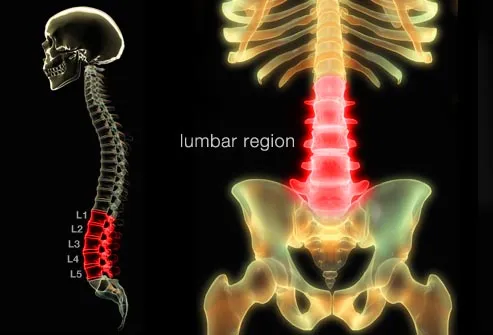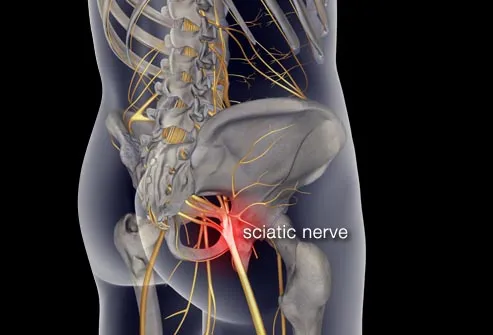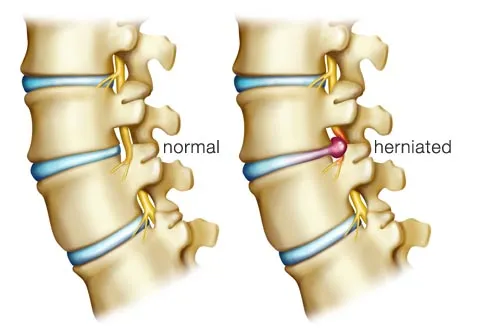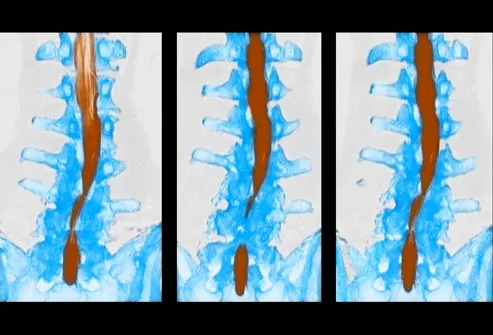Berikut merupakan kutipan ilmiah medis dari media online yang sangat bermanfaat sehingga digunakan sebagai referensi pribadi.

What Is Low Back Pain?
Low back pain is a universal human experience -- almost everyone has it at some point. The lower back, which starts below the ribcage, is called the lumbar region. Pain here can be intense and is one of the top causes of missed work. Fortunately, low back pain often gets better on its own. When it doesn't, there are effective treatments.
Symptoms of Low Back Pain
Symptoms range from a dull ache to a stabbing or shooting sensation. The pain may make it hard to move or stand up straight. Acute back pain comes on suddenly, often after an injury from sports or heavy lifting. Pain that lasts more than three months is considered chronic. If your pain is not better within 72 hours, you should consult a doctor.
Symptoms That Require Urgent Care
Severe back pain after a fall or injury should be checked out by a health care professional. Other warning signs include a loss of bowel or bladder control, leg weakness, fever, and pain when coughing or urinating. If you have any of these symptoms along with your back pain, contact your doctor.

Muscle Strain or Sciatica?
The kind of back pain that follows heavy lifting or exercising too hard is often caused by muscle strain. But sometimes back pain can be related to a disc that bulges or ruptures. If a bulging or ruptured disc presses on the sciatic nerve, pain may run from the buttock down one leg. This is called sciatica.
Back Pain Culprit: Your Job
If your job involves lifting, pulling, or anything that twists the spine, it may contribute to back pain. However, sitting at a desk all day comes with risks of its own, especially if your chair is uncomfortable or you tend to slouch.
Back Pain Culprit: Your Bag
Although you may wear your purse, backpack, or briefcase over your shoulder, it is the lower back that supports the upper body -- including any additional weight you carry. So an overstuffed bag can strain the lower back, especially if you carry it day after day. If you must tote a heavy load, consider switching to a wheeled briefcase.
Back Pain Culprit: Your Posture
Mom was right when she said, "Stand up straight!" Your back supports weight best when you don't slouch. This means sitting with good lumbar support for your lower back, shoulders back, with feet resting on a low stool. When standing, keep weight evenly balanced on both feet.

Back Pain Culprit: Herniated Disc
The spine's vertebrae are cushioned by gel-like discs that are prone to wear and tear from aging or injuries. A weakened disc may rupture or bulge, putting pressure on the spinal nerve roots. This is known as a herniated disc and can cause intense pain.

Back Pain Culprit: Chronic Conditions
Several chronic conditions can lead to low back pain.
- Spinal stenosis is a narrowing of the space around the spinal cord, which can put pressure on the spinal nerves.
- Spondylitis refers to chronic back pain and stiffness due to severe inflammation of the spinal joints.
- Fibromyalgia causes widespread muscle aches, including back pain.
Who's at Risk for Low Back Pain?
Most people get their first taste of low back pain in their 30s. The odds of additional attacks increase with age. Other reasons your low back may hurt include:- Being overweight
- Inactive lifestyle
- Jobs that require heavy lifting
Diagnosing Low Back Pain
To help your doctor diagnose the source of low back pain, be specific in describing the type of pain, when it started, related symptoms, and any history of chronic conditions. Your doctor may order X-rays, CT or MRI scans to look for damaged bones or discs, or other injuries to the spine.Home Care for Low Back Pain
Back pain due to muscle strain will usually get better on its own, but you can take steps to make yourself more comfortable. A heating pad or warm baths may provide temporary pain relief.The Bed Rest Debate
When your back hurts, you may not feel like getting out of bed. But if the problem is muscle strain, doctors recommend returning to your normal activities as soon as possible. Studies suggest that any more than a day or two of bed rest can actually make the pain worse and may reduce muscle tone and flexibility.Yoga
If back pain doesn't go away in three months, there's evidence that yoga can help. In one recent study, people who took 12 weeks of yoga classes had fewer symptoms of low back pain than people who were given a book about care for back pain. The benefits lasted several months after the classes were finished. The study suggests conventional stretching also works just as well. Make sure your instructor is experienced at teaching people with back pain and will modify postures for you as needed.Spinal Manipulation
Chiropractors and some osteopathic doctors use spinal manipulation to treat low back pain by applying pressure with their hands to bones and surrounding tissues. This treatment is not appropriate for everyone.Massage Therapy
A study funded by the government suggests that massage may help relieve chronic low back pain. After 10 weeks, people who had weekly massages had less pain and were better able to go about their daily activities than people who got traditional care. That was true no matter what type of massage they got, and the benefits lasted at least six months.- Sumber : MD
Tidak ada komentar:
Posting Komentar